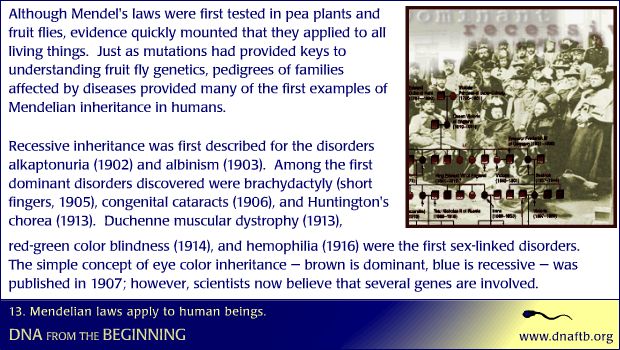Concept 13: Mendelian laws apply to human beings.

Family pedigrees provided evidence of Mendelian inheritance in humans.
Although Mendel's laws were first tested in pea plants and fruit flies, evidence quickly mounted that they applied to all living things. Just as mutations had provided keys to understanding fruit fly genetics, pedigrees of families affected by diseases provided many of the first examples of Mendelian inheritance in humans. Recessive inheritance was first described for the disorders alkaptonuria (1902) and albinism (1903). Among the first dominant disorders discovered were brachydactyly (short fingers, 1905), congenital cataracts (1906), and Huntington's chorea (1913). Duchenne muscular dystrophy (1913), red-green color blindness (1914), and hemophilia (1916) were the first sex-linked disorders. The simple concept of eye color inheritance — brown is dominant, blue is recessive — was published in 1907; however, scientists now believe that several genes are involved.
eye color inheritance, red green color blindness, fruit fly genetics, mendelian laws, family pedigrees, inheritance in humans, sex linked disorders, pea plants, fruit flies, albinism, hemophilia, mendel, muscular dystrophy, chorea
- ID: 16314
- Source: DNALC.DNAFTB
Related Content
16262. Concept 10: Chromosomes carry genes.
Fruit flies help to reveal that chromosomes carry genes.
16315. Animation 13: Mendelian laws apply to human beings.
Queen Victoria explains pedigrees using the royal family and its inheritance of hemophilia.
16263. Chromosomes carry genes.
DNAFTB Animation 10:Thomas Hunt Morgan describes his discoveries using fruit flies.
15940. What is color blindness?
The two genes that produce red and green light-sensitive proteins are located on the X chromosome.
16278. Chromosomes carry genes.
DNAFTB Problem 10: Perform some fruit fly crosses.
10311. "The relation of hereditary eye defects to genetics and eugenics," by Lucien Howe, JAMA (2)
"The relation of hereditary eye defects to genetics and eugenics," by Lucien Howe, JAMA (2)
10313. "The relation of hereditary eye defects to genetics and eugenics," by Lucien Howe, JAMA (4)
"The relation of hereditary eye defects to genetics and eugenics," by Lucien Howe, JAMA (4)
15419. X chromosome: gene for color blindness, Matt Ridley
Matt Ridley talks about X chromosome: gene for color blindness.
10310. "The relation of hereditary eye defects to genetics and eugenics," by Lucien Howe, JAMA (1)
"The relation of hereditary eye defects to genetics and eugenics," by Lucien Howe, JAMA (1)
10989. "Pedigree of family with color blindness. (Sex limited)."
"Pedigree of family with color blindness. (Sex limited)."












